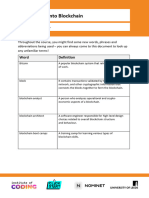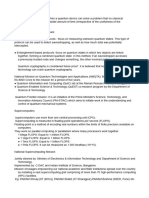General Blockchain Concepts
Blockchain
Definition: A digital ledger that records transactions securely across a
network of computers. Data is stored in blocks and linked chronologically.
Example: Bitcoin’s blockchain records every transaction since its creation in
2009.
Use Case: Used in cryptocurrencies, supply chain tracking, healthcare, and
voting systems.
Distributed Ledger
Definition: A synchronized, decentralized database shared across a network.
Example: Hyperledger Fabric is a popular enterprise distributed ledger
platform.
Use Case: Banks use distributed ledgers for faster cross-border payments.
Smart Contract
Definition: Self-executing programs that run on a blockchain and execute
automatically when predefined conditions are met.
Example: Ethereum enables smart contracts for token sales, escrow services,
and voting systems.
Use Case: A real estate transaction where funds are released only when
ownership changes.
Consensus Mechanism
Definition: Protocols used by blockchains to agree on the validity of
transactions.
Example: Bitcoin uses Proof of Work (miners solve puzzles), while Ethereum
uses Proof of Stake (validators lock tokens to validate transactions).
Use Case: Ensures trust in decentralized systems without intermediaries.
Untitled 1
� Immutable
Definition: Blockchain data cannot be modified or deleted once recorded.
Example: A charity donation recorded on the blockchain is permanently
visible.
Use Case: Ensures tamper-proof audit trails for financial records or legal
contracts.
Gas
Definition: The fee required to process transactions or execute smart
contracts on blockchains like Ethereum.
Example: Sending 1 ETH might cost 0.002 ETH as gas during low traffic but
can spike during congestion.
Use Case: Encourages miners or validators to prioritize transactions.
Hash
Definition: A cryptographic string that uniquely represents data.
Example: SHA-256 is used by Bitcoin to generate a unique hash for each
block.
Use Case: Verifies data integrity in supply chains and digital signatures.
Node
Definition: A computer that participates in maintaining a blockchain network.
Example: Full nodes store the entire blockchain and validate transactions,
while light nodes store only essential data.
Use Case: Ensures decentralization and reliability of the blockchain.
Fork
Definition: A split in the blockchain protocol that can result in two versions of
the blockchain.
Hard Fork: Creates two separate blockchains with no compatibility (e.g.,
Ethereum and Ethereum Classic after the DAO hack).
Untitled 2
� Soft Fork: Backward-compatible updates (e.g., Bitcoin's SegWit).
Use Case: Introduces updates, new features, or resolves community disputes.
Decentralization
Definition: No central authority controls the system; all participants share
control.
Example: Bitcoin operates without a central bank.
Use Case: Secure, censorship-resistant systems for finance, identity, or
communication.
Genesis Block
Definition: The first block created on a blockchain.
Example: Bitcoin’s genesis block was mined by Satoshi Nakamoto on January
3, 2009.
Use Case: Establishes the starting point of the blockchain.
Merkle Tree
Definition: A data structure used for efficient verification of blockchain
transactions.
Example: Bitcoin uses Merkle Trees to summarize and verify transactions
within a block.
Use Case: Enhances scalability and verification speed.
Cryptography and Security Concepts
Private Key
Definition: A secret key used to sign transactions and access funds.
Example: Wallets like MetaMask generate private keys that must remain
confidential.
Use Case: Enables secure ownership of cryptocurrency.
Untitled 3
� Public Key
Definition: A cryptographic key shared publicly to receive funds or messages.
Example: Bitcoin addresses are derived from public keys.
Use Case: Allows others to send funds securely without revealing the private
key.
Digital Signature
Definition: A cryptographic signature proving ownership of a transaction or
message.
Example: Signing a Bitcoin transaction with a private key creates a digital
signature.
Use Case: Validates the sender’s authenticity without exposing sensitive
information.
Encryption
Definition: Converting data into a code to prevent unauthorized access.
Example: Secure wallets encrypt private keys for safekeeping.
Use Case: Ensures privacy in blockchain communication and data storage.
Zero-Knowledge Proofs (ZKP)
Definition: A method to prove something is true without revealing the actual
data.
Example: zk-SNARKs in Zcash enable private transactions.
Use Case: Enhances privacy in financial transactions and identity verification.
Ecosystem-Specific Terms
Ethereum Virtual Machine (EVM)
Definition: The runtime environment for executing smart contracts on
Ethereum.
Untitled 4
� Example: Solidity smart contracts are deployed and executed within the EVM.
Use Case: Powers decentralized applications and DeFi platforms.
Oracles
Definition: Services that connect blockchains to real-world data.
Example: Chainlink provides price feeds for DeFi platforms.
Use Case: Allows smart contracts to access external information like weather,
sports scores, or stock prices.
Bridges
Definition: Tools to transfer assets or data between different blockchains.
Example: WBTC (Wrapped Bitcoin) bridges Bitcoin to Ethereum as a token.
Use Case: Facilitates cross-chain transactions and interoperability.
Sharding
Definition: A scalability solution that splits a blockchain into smaller pieces, or
“shards.”
Example: Ethereum 2.0 plans to implement sharding to improve performance.
Use Case: Allows blockchains to process more transactions in parallel.
Atomic Swap
Definition: A smart contract that enables the direct exchange of
cryptocurrencies between two parties without intermediaries.
Example: Swap Bitcoin for Litecoin using a protocol like Komodo.
Use Case: Facilitates decentralized trading without relying on exchanges.
Decentralized Systems
DApps (Decentralized Applications)
Definition: Applications built on a blockchain that run without central servers.
Untitled 5
� Example: Uniswap is a decentralized exchange DApp on Ethereum.
Use Case: Peer-to-peer finance, gaming, and social media.
DAO (Decentralized Autonomous Organization)
Definition: Organizations governed by smart contracts and token holders.
Example: MakerDAO manages the DAI stablecoin via community voting.
Use Case: Enables collective decision-making without a central authority.
Decentralized Exchange (DEX)
Definition: A platform for peer-to-peer cryptocurrency trading without
intermediaries.
Example: SushiSwap and PancakeSwap.
Use Case: Allows trustless and permissionless trading.
Liquidity Pool
Definition: A pool of funds provided by users for trading on a DEX.
Example: Users provide ETH and USDT on Uniswap to earn fees from traders.
Use Case: Facilitates seamless trading and earns passive income for liquidity
providers.
Staking
Definition: Locking cryptocurrency to support blockchain operations and earn
rewards.
Example: Stake ETH on Ethereum 2.0 to secure the network.
Use Case: Provides incentives for network participation and reduces energy
usage.
Yield Farming
Definition: Earning rewards by lending or staking crypto in DeFi platforms.
Example: Deposit USDC on Yearn Finance to earn compounded interest.
Untitled 6
� Use Case: Maximizes returns for DeFi users.
Emerging Trends
Soulbound Tokens (SBTs)
Definition: Non-transferable tokens representing identity or achievements.
Example: A university degree as an SBT tied to your wallet.
Use Case: Enhances trust in Web3 identity and credentials.
Digital Twin
Definition: A digital replica of a physical object stored on a blockchain.
Example: A car's ownership, maintenance history, and insurance are recorded
on a blockchain as its digital twin.
Use Case: Improves transparency in industries like real estate or
manufacturing.
Fractional Ownership
Definition: Splitting ownership of high-value assets into smaller, tradeable
units.
Example: Owning 1% of a famous artwork via NFTs on Fractional.art.
Use Case: Democratizes access to expensive investments like real estate or
collectibles.
Play-to-Earn (P2E)
Definition: Games that reward players with cryptocurrencies or NFTs.
Example: Axie Infinity players earn tokens by battling and trading Axies.
Use Case: Incentivizes engagement in gaming.
Move-to-Earn (M2E)
Definition: Platforms that reward physical activity with crypto.
Untitled 7
� Example: StepN rewards users for walking or running with NFTs and tokens.
Use Case: Encourages healthier lifestyles while earning rewards.
SocialFi (Social Finance)
Definition: Platforms that integrate social networking with blockchain-based
finance.
Example: Rally.io allows creators to launch their own social tokens.
Use Case: Enables monetization of community engagement.
GameFi (Gaming Finance)
Definition: Combines blockchain gaming with financial incentives like tokens
or NFTs.
Example: Players in The Sandbox earn NFTs by building virtual worlds.
Use Case: Transforms gaming into an earning opportunity.
Blockchain Financial Systems
DeFi (Decentralized Finance)
Definition: Financial services provided without intermediaries using
blockchain technology.
Example: Aave allows users to lend or borrow crypto without a bank.
Use Case: Provides global access to financial tools like lending, borrowing,
and trading.
CeFi (Centralized Finance)
Definition: Financial services that operate on crypto but involve a central
authority.
Example: Binance and Coinbase offer CeFi platforms for trading.
Use Case: Simplifies onboarding for new crypto users with centralized
support.
Untitled 8
� TradFi (Traditional Finance)
Definition: Conventional financial systems like banks, insurance, and stock
markets.
Example: JPMorgan offering blockchain-based settlement solutions.
Use Case: Integrates blockchain technology for better efficiency and security.
Stablecoin
Definition: Cryptocurrencies pegged to a stable asset like the US Dollar.
Example: USDC is a fiat-backed stablecoin.
Use Case: Reduces volatility and enables secure payments.
CBDC (Central Bank Digital Currency)
Definition: Digital currency issued and regulated by a central bank.
Example: China’s Digital Yuan (e-CNY).
Use Case: Offers secure, digital alternatives to physical cash.
Infrastructure and Tools
Layer 1
Definition: The base blockchain layer.
Example: Bitcoin and Ethereum are Layer 1 blockchains.
Use Case: Processes and secures transactions directly on-chain.
Layer 2
Definition: Scalability solutions built on top of Layer 1.
Example: Polygon and Optimism process transactions off-chain but settle
them on Ethereum.
Use Case: Reduces congestion and fees on the main blockchain.
Tokenomics
Untitled 9
� Definition: The economic model of a blockchain or token, including supply,
distribution, and utility.
Example: Bitcoin’s halving reduces supply to drive value.
Use Case: Guides project development and community incentives.
Mining
Definition: The process of solving cryptographic puzzles to validate
transactions and add blocks.
Example: Bitcoin miners compete to solve Proof of Work puzzles.
Use Case: Secures networks and incentivizes participants.
Validator
Definition: A participant in Proof of Stake systems who validates transactions
by locking tokens.
Example: Ethereum 2.0 validators earn ETH rewards by staking.
Use Case: Replaces mining in energy-efficient blockchain systems.
Untitled 10



























































































